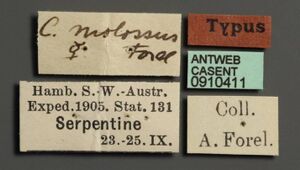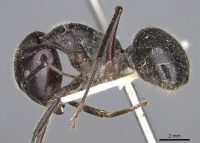Camponotus molossus
| Camponotus molossus | |
|---|---|

| |
| Scientific classification | |
| Kingdom: | Animalia |
| Phylum: | Arthropoda |
| Class: | Insecta |
| Order: | Hymenoptera |
| Family: | Formicidae |
| Subfamily: | Formicinae |
| Tribe: | Camponotini |
| Genus: | Camponotus |
| Species: | C. molossus |
| Binomial name | |
| Camponotus molossus Forel, 1907 | |
These ants have been observed to farm leafhoppers (Cicadellidae) for honeydew, and most likely tend other Hemiptera as well. They seem to nest exclusively in old(?) termite mounds and build a tubular entrance to it out of plant fibres and other debris.
Photo Gallery
Identification
Keys including this Species
- Key to Australian Camponotus majors of the southwestern Botanical Province
- Key to Australian Camponotus minors of the southwestern Botanical Province
- Key to Australian Camponotus species
Distribution
Latitudinal Distribution Pattern
Latitudinal Range: -34.7818° to -37.07500076°.
| North Temperate |
North Subtropical |
Tropical | South Subtropical |
South Temperate |
- Source: AntMaps
Distribution based on Regional Taxon Lists
Australasian Region: Australia (type locality).
Distribution based on AntMaps
Distribution based on AntWeb specimens
Check data from AntWeb
Countries Occupied
| Number of countries occupied by this species based on AntWiki Regional Taxon Lists. In general, fewer countries occupied indicates a narrower range, while more countries indicates a more widespread species. |

|
Estimated Abundance
| Relative abundance based on number of AntMaps records per species (this species within the purple bar). Fewer records (to the left) indicates a less abundant/encountered species while more records (to the right) indicates more abundant/encountered species. |

|
Biology
The nesting habits and preference for honeydew shown by this species seemingly bring them in to direct competition with Iridomyrmex purpureus (in southern Western Australia and likely elsewhere), which are the dominant ant in this area. This elicits a response in the Iridomyrmex which sees workers sabotage the nest entrance of C. molossus colonies by placing stones and other debris across it in an attempt to block the hole. Camponotus molossus workers are mostly seen foraging at night when Iridomyrmex workers are not active.
Jean Hort has photographed and taken a video of this behaviour.
Castes
Images from AntWeb
   
| |
| Worker. Specimen code casent0906939. Photographer Michele Esposito, uploaded by California Academy of Sciences. | Owned by NHMUK, London, UK. |
   
| |
| Syntype of Camponotus molossus. Worker (major/soldier). Specimen code casent0910410. Photographer Z. Lieberman, uploaded by California Academy of Sciences. | Owned by MHNG, Geneva, Switzerland. |
   
| |
| Syntype of Camponotus molossus. Worker. Specimen code casent0910411. Photographer Z. Lieberman, uploaded by California Academy of Sciences. | Owned by MHNG, Geneva, Switzerland. |
Nomenclature
The following information is derived from Barry Bolton's Online Catalogue of the Ants of the World.
- molossus. Camponotus molossus Forel, 1907h: 306 (s.w.) AUSTRALIA (Western Australia).
- Wheeler, G.C. & Wheeler, J. 1968: 218 (l.).
- Combination in C. (Myrmosphincta): Forel, 1914a: 273;
- combination in C. (Myrmosaulus): Emery, 1925b: 114.
- Status as species: Emery, 1925b: 114; Taylor & Brown, 1985: 117; Taylor, 1987a: 13; Bolton, 1995b: 112; Heterick, 2009: 63; McArthur, 2014: 110.
Type Material
- Syntype, 1 worker, Serpentine, Western Australia, Australia, Australian National Insect Collection.
- Syntype, workers, Buckland Hill, Western Australia, Australia, Musee d'Histoire Naturelle Genève.
- Syntype, 1 worker, Serpentine, Western Australia, Australia, Western Australian Museum.
Unless otherwise noted the text for the remainder of this section is reported from the publication that includes the original description.
Description
Worker major Length 11-16 mm. Head 5 mm wide and 5 mm long, without the mandibles. Mandibles with 7-8 teeth, with weakly convex outer edge, glossy, extremely finely and irregularly punctate reticulate; in addition scattered coarse punctations, towards the outer edge coarse long strips and everywhere rather ample covering of upstanding hair. Clypeus at the anterior and at the posterior with a trace of a keel in the middle, in front forming a short trapezoidal lobe whose anterior edge is very shallow concave (almost straight). Head rounded trapeze shape, posterior wider than anterior, in addition where, near the mandibles attachment more strongly narrowing, posterior strongly concave with rather convex sides. The scape protrudes over the posterior head for about 1/4 of its length. Eyes rather flat, almost round. Frontal ridges S shaped, moderately diverging. Frontal area triangular, indistinct. Promesonotum moderately convex; promesonotal suture deeply imprinted. Basal surface of the metanotum (= propodeum) standing rather deeper than the mesonotum, strongly transversely convex, but its length is not quite horizontal, joining with a similar length sloping surface in a rounded curve. Node narrow, but very large, almost in the shape of a knot, below especially strongly thickened, above (seen from the side)thinned down cone shaped, but therefore very blunt.Tibias cylindrical without barbs. Glossy, to softly shining. Head thickly and finely reticulate, the rest, also the limbs more finely transversely striate; thorax reticulate striate. Moreover regular scattered not coarse and rather shallow punctations. On the gaster the punctations are not so deep; on the limbs they are numerous and on the clypeus and cheeks coarser, in parts elongated. Very ample, brownish yellow, covering of upstanding hair, sharp but not long. The flat-lying covering of hair is extremely scattered and inconspicuous. The tibias are especially thickly and richly bristled. Black; tarses, mandibles and antennae brown. Sometimes a much weaker dark blue metallic shimmer which however seems to fade away as I saw it clearly in the beginning, but then no more.
Worker minor. Clypeus distinctly keeled with an arc shaped anterior border. Eyes convex. Head somewhat longer than wide, rectangular from the front corners to behind the eyes, with parallel sides, behind the eyes up to the articulation the head becomes narrower with convex sides without forming a neck, so that from one eye to the other the posterior margin forms a strong convexity. Promesonotum convexity is weaker than with the major worker. Node rounded, knot shaped, the base thicker than high. Otherwise like the worker major.
Station 114, Buckland Hill; Stat. 131 Serpentine.
Very closely related to intrepidus Kirby especially the subspecies bellicosus Forel but broader and colored differently. Perhaps only a sub species.
References
- Emery, C. 1925d. Hymenoptera. Fam. Formicidae. Subfam. Formicinae. Genera Insectorum 183: 1-302 (page 114, Combination in C. (Myrmosaulus))
- Forel, A. 1907j. Formicidae. In: Michaelsen, W., Hartmeyer, R. (eds.) Die Fauna Südwest-Australiens. Band I, Lieferung 7. Jena: Gustav Fischer, pp. 263-310. (page 306, soldier, worker described)
- Forel, A. 1914a. Le genre Camponotus Mayr et les genres voisins. Rev. Suisse Zool. 22: 257-276 (page 273, Combination in C. (Myrmosphincta))
- Heterick, B.E. 2021. A guide to the ants of Western Australia. Part I: Systematics. Records of the Western Australian Museum, Supplement 86, 1-245 (doi:10.18195/issn.0313-122x.86.2021.001-245).
- Heterick, B.E. 2022. A guide to the ants of Western Australia. Part II: Distribution and biology. Records of the Western Australian Museum, supplement 86: 247-510 (doi:10.18195/issn.0313-122x.86.2022.247-510).
- Wheeler, G. C.; Wheeler, J. 1968a. The ant larvae of the subfamily Formicinae (Hymenoptera: Formicidae): supplement. Ann. Entomol. Soc. Am. 61: 205-222 (page 218, larva described)






